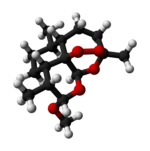Artemether
 | |
 | |
| Clinical data | |
|---|---|
| Trade names | Many[1] |
| AHFS/Drugs.com | International Drug Names |
| Routes of administration | Intramuscular[2] Oral |
| ATC code | |
| Legal status | |
| Legal status |
|
| Identifiers | |
| |
JSmol) | |
| Melting point | 86 to 88 °C (187 to 190 °F) |
| |
| |
| | |
Artemether is a medication used for the treatment of
Artemether causes relatively few side effects.
Artemether has been studied since at least 1981, and has been in medical use since 1987.[5] It is on the World Health Organization's List of Essential Medicines.[6]
Medical uses
Artemether is an antimalarial drug for uncomplicated malaria caused by P. falciparum (and chloroquine-resistant P. falciparum) or chloroquine-resistant P. vivax parasites.[1][7] Artemether can also be used to treat severe malaria.[2]
The
Artemether can also be used in treating and preventing trematode infections of schistosomiasis when used in combination with praziquantel.[10]
Artemether is rated category C by the FDA based on animal studies where artemisinin derivatives have shown an association with fetal loss and deformity. Some studies, however, do not show evidence of harm.[11][12]
Side effects
Possible side effects include cardiac effects such as bradycardia and QT interval prolongation.[1][13] Also, possible central nervous system toxicity has been shown in animal studies.[14][15]
Drug interactions
Plasma artemether level was found to be lower when the combination product was used with lopinavir/ritonavir.[15] There is also decreased drug exposure associated with concurrent use with efavirenz or nevirapine.[16][17]
Artemether/lumefantrine should not be used with drugs that inhibit CYP3A4.[1][18]
Hormonal contraceptives may not be as efficacious when used with artemether/lumefantrine.[18]
Pharmacology
Mechanism of action
A possible mechanism of action is that artemisinin drugs exert their cidal action by inhibiting PfATP6. Since PfATP6 is an enzyme regulating cellular calcium concentration, its malfunctioning will lead to intracellular calcium accumulation, which in turns causes cell death.[19]
Pharmacokinetics
Absorption of artemether is improved 2- to 3-fold with food. It is highly bound to protein (95.4%). Peak concentrations of artemether are seen 2 hours after administration.[3]
Artemether is metabolized in the human body to the active metabolite, dihydroartemisinin, primarily by hepatic enzymes CYP3A4/5.[3] Both the parent drug and active metabolite are eliminated with a half-life of about 2 hours.[3]
Chemistry
Artemether is a methyl ether derivative of artemisinin, which is a peroxide-containing lactone isolated from the antimalarial plant Artemisia annua. It is also known as dihydroartemisinin methyl ether, but its correct chemical nomenclature is (+)-(3-alpha,5a-beta,6-beta,8a-beta, 9-alpha,12-beta,12aR)-decahydro-10-methoxy-3,6,9-trimethyl-3,12-epoxy-12H-pyrano(4,3-j)-1,2-benzodioxepin. It is a relatively lipophilic and unstable drug,[20] which acts by creating reactive free radicals in addition to affecting the membrane transport system of the plasmodium organism.[13]
References
- ^ a b c d e f "Artemether and Lumefantrine (Monograph)". Drugs.com. 22 February 2023. Retrieved 17 February 2024.
- ^ PMID 31210357.
- ^ a b c d "Coartem- artemether and lumefantrine tablet". DailyMed. 5 August 2019. Retrieved 26 April 2020.
- ^ PMID 25556421.
- ISBN 9789813109919. Archivedfrom the original on 2017-09-10.
- hdl:10665/325771. WHO/MVP/EMP/IAU/2019.06. License: CC BY-NC-SA 3.0 IGO.
- PMID 19818172.
- ^ Treatment of Uncomplicated Plasmodium falciparum Malaria. World Health Organization. 2015-01-01. Archived from the original on 2017-09-10.
- ^ Treatment Of Uncomplicated Malaria Caused By P. vivax, P. ovale, P. malariae or P. knowlesi. World Health Organization. 2015-01-01. Archived from the original on 2017-09-10.
- PMID 23029285.
- PMID 17300719.
- PMID 20932805.
- ^ a b "Artemether". www.antimicrobe.org. Archived from the original on 2017-02-23. Retrieved 2016-11-09.
- ^ "WHO Model Prescribing Information: Drugs Used in Parasitic Diseases - Second Edition: Protozoa: Malaria: Artemether". apps.who.int. Archived from the original on 2016-11-10. Retrieved 2016-11-09.
- ^ PMID 22985344.
- PMID 24528518.
- S2CID 1281113.
- ^ S2CID 7678606.
- PMID 27006895.
- PMID 22770733.
